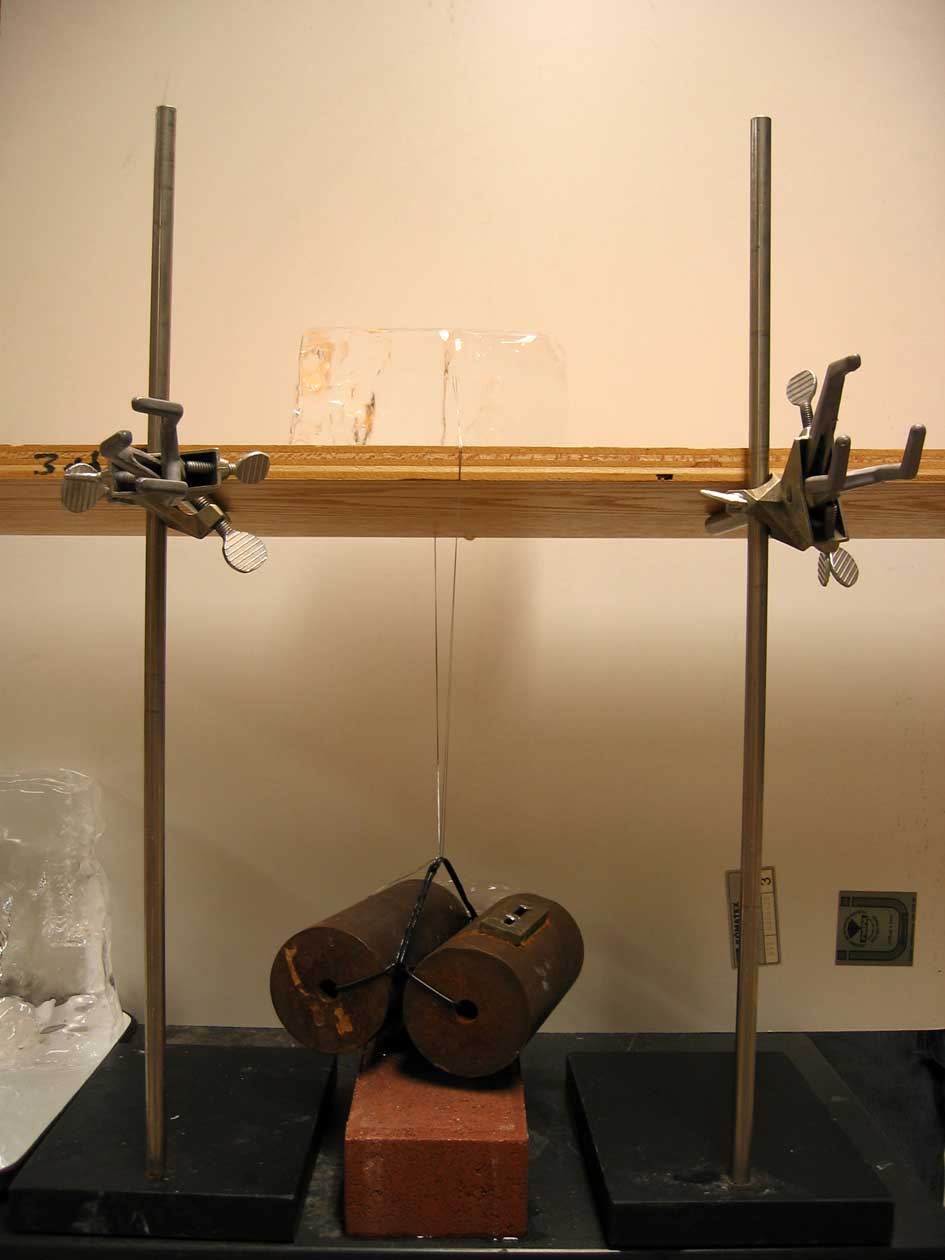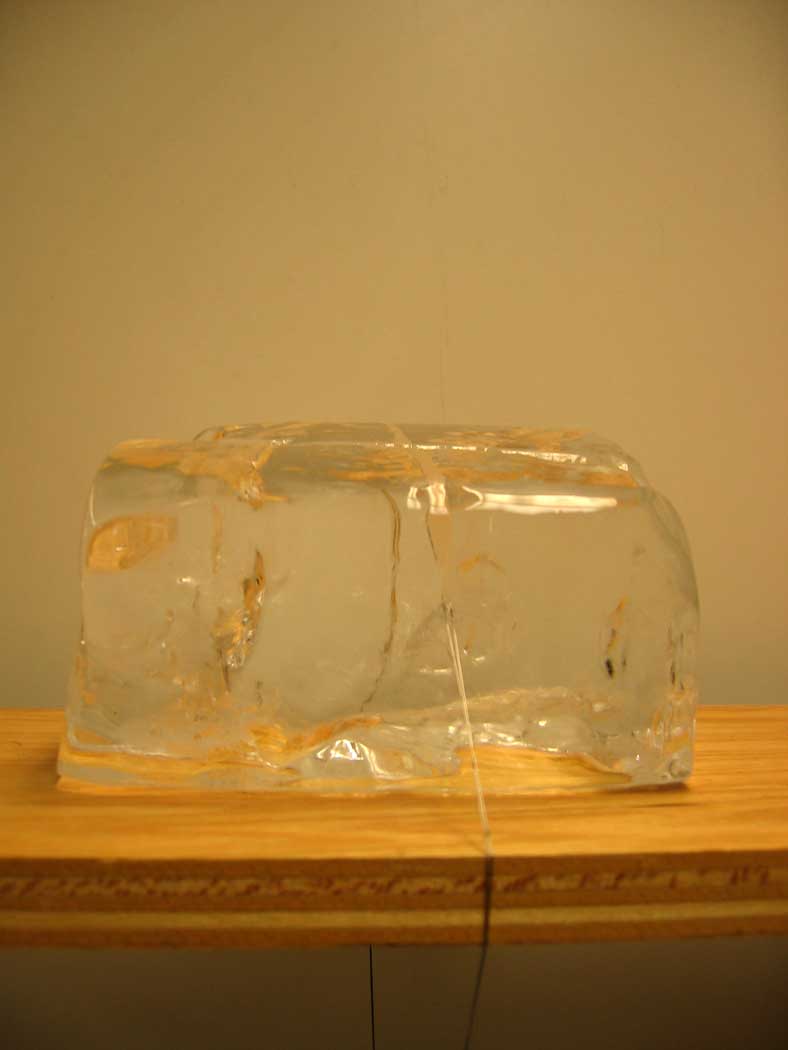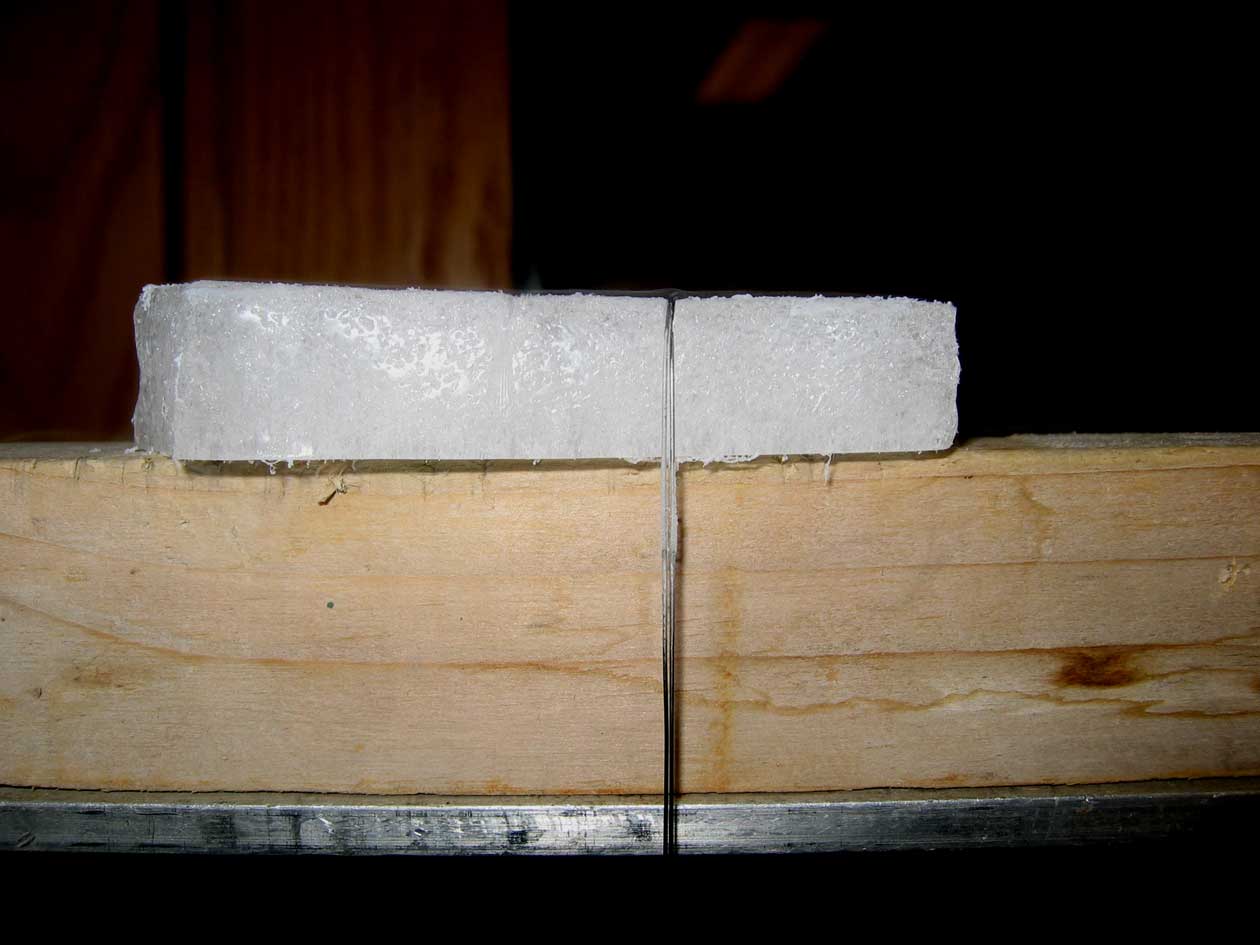Solid to liquid phase transitions in "wet ice" and "dry ice"
 Pieces of "wet ice" and "dry ice" are placed under substantial pressure. Surprisingly, one melts and the other does not.
Pieces of "wet ice" and "dry ice" are placed under substantial pressure. Surprisingly, one melts and the other does not.
Ingredients: water "wet ice," carbon dioxide "dry ice," thin wire, weight
Procedure: A complete recipe follows.
1. Place a piece of water ice on a wooden board.
2. Drape a thin metal wire over the ice, and hang a heavy weight from the wire.
3. Observe the action of the wire on the ice.
4. Repeat the experiment using dry ice and compare the results.
Understanding: In the neighborhood of the melting point, most solids are more dense than the corresponding liquids. There are a few notable exceptions to this rule, one being water. You have seen the results of that exception. When liquid water and water ice coexist in a glass at the melting temperature, the solid ice floats on the liquid water.
 Think of how different our world would be if that were not so. When a lake freezes over in winter, ice remains on top of the liquid water, insulating it from changes in temperature and protecting the plant and animal life below it. If the ice were more dense than the liquid, the ice would form at the bottom of the lake. The ice would be insulated by the water above. In cold regions, the ice would gradually build up over time causing the full volume of the lake to form solid ice, making life as we know it impossible.
Think of how different our world would be if that were not so. When a lake freezes over in winter, ice remains on top of the liquid water, insulating it from changes in temperature and protecting the plant and animal life below it. If the ice were more dense than the liquid, the ice would form at the bottom of the lake. The ice would be insulated by the water above. In cold regions, the ice would gradually build up over time causing the full volume of the lake to form solid ice, making life as we know it impossible.
In our experiment, we put water ice and dry ice under pressure, using a thin metal wire and a great weight. The force of gravity distributed over the thin wire creates a large force per unit area - a very great pressure!
The great pressure on the water ice creates a remarkable effect. The wire is able to slowly cut through the ice block. The water directly under the wire is under great pressure. The increased pressure at constant temperature causes the ice to undergo a solid to liquid phase transition - it melts and allows the wire to pass.
Something interesting also happens after the wire has passed. The water above the wire freezes again! When the pressure is reduced, the liquid water undergoes a phase transition to form solid water ice.

The same experiment carried out using dry ice leads to dramatically different results. The dry ice under pressure does not melt! Of course, you say, it is dry ice. But hold on! It also does not sublimate! The pressure on the solid carbon dioxide is raised dramatically, and there is no phase transition. We simply create a solid at high pressure.
It turns out that no matter how high we make the pressure, adding additional weights to our wire, as long as the dry ice remains at the same temperature we will never see the dry ice melt or sublimate. At the normal sublimation temperature (the sublimation temperature at one atmosphere of pressure), the dry ice will remain in the solid phase no matter how high the pressure.
The contrast in the behavior of ices under pressure reflects the dramatic differences in molecular structure and intermolecular forces in water and in carbon dioxide. It is used as a common explanation for our ability to ice skate on water ice. The skate blade is quite thin. The skater's mass creates a gravitational force that is distributed over the small area of the narrow skate blade, creating a high pressure. If it is not too cold, the increased pressure on the ice will cause it to melt, creating a thin layer of liquid water between the water ice and the skate blade, lowering the friction and allowing the skate to glide over the ice.
Of course, there are limits to where - on the phase diagram - one can skate. If the temperature is near the melting point, only a slight increase in pressure can cause the water ice to melt. However, if the temperature is very cold, it will take a greater pressure to cause the ice to melt.
Drawing the liquid-solid coexistence line of pressure-temperature phase diagrams
Question: Draw the phase diagrams of water and carbon dioxide. Indicate the gas, liquid and solid phase regions. Arrange the relative positions of the triple points to reflect the very different natures of the intermolecular interactions. Orient the liquid-solid coexistence line to reflect the results of our exploration of dry ice and water ice under pressure.Under pressure
Question: Estimate the pressure of the ice directly beneath the wire. The total mass of the weights is 24 pounds. The diameter of the wire is 0.3 millimeters. The width of the ice block is 2 inches. Compute the pressure under the wire in pascals, atmospheres, and pounds per square inch.Skating on Mars
Question: The polar ice caps of Earth are composed of water ice. The polar ice caps of Mars contain solid carbon dioxide - dry ice. Imagine exploring the polar regions of Mars for the first time. Naturally, you brought your skates!Take your ice skate blade to be 1/8 of an inch wide. And how long? A foot, of course! Using a detailed phase diagram of carbon dioxide, and the knowledge that the temperature in the polar region at the time is -128C (-200F), draw on the phase diagram the line showing the range of temperature and pressure explored by your skate pressing on the dry ice cap. Can you skate on Mars?